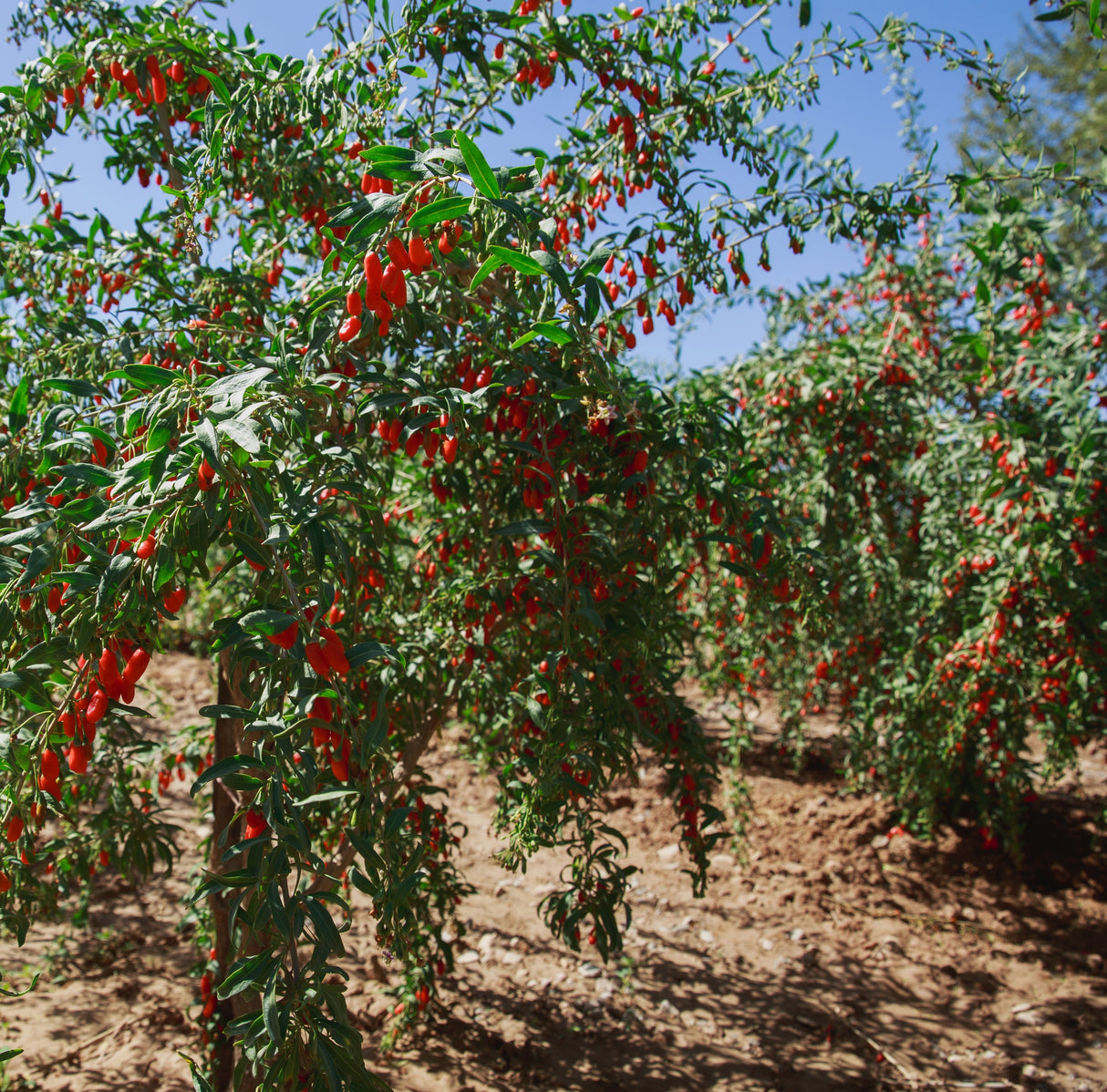Goji Berry Plant
Plant Health Guaranteed
Your Plants are Guaranteed
Your Plants are Guaranteed
Your plants are guaranteed to arrive happy & healthy with our 30 Day Plant Promise. Your order will arrive healthy and stay healthy while they adapt to your climate. If not, just call us at (704) 443-8256.
Free Shipping on All Orders
Free Shipping on All Orders
Free shipping on all orders. Your plants will ship out the next business day... expertly packed so that your plants will arrive happy and healthy!
Planting & Care
Planting & Care
|
The Goji Berry Plant thrives in Zones 5-9 
If you live in the green area above, we recommend the Goji Berry Plant. |
||
| Your Growing Zone | ||
| Recommended Zones | 5-9 | |
| Mature Height | 8-10 ft. | |
| Mature Width | 4-6 ft. | |
| Cannot Ship To | AZ, OR | |
| Sunlight | Full to Partial Sun | |
| Botanical Name | Lycium barbarum | |
|
The Goji Berry Plant thrives in Zones 5-9 
If you live in the green area above, we recommend the Goji Berry Plant. |
|
| Your Growing Zone | |
| Recommended Zones | 5-9 |
| Mature Height | 8-10 ft. |
| Mature Width | 4-6 ft. |
| Cannot Ship To | AZ, OR |
| Sunlight | Full to Partial Sun |
| Botanical Name | Lycium barbarum |
Description
Description
Goji Berry – Superfood Packed with Nutrients for Your Garden
Bring a powerhouse of nutrition and beauty to your garden with the Goji Berry! Famous for its health benefits and antioxidant-rich fruit, the Goji Berry plant produces an abundance of bright red berries packed with vitamins and minerals. These small, tangy-sweet berries have long been used in traditional medicine and are perfect for snacking, smoothies, teas, or drying for later use. With its hardy, easy-to-grow nature and vibrant appearance, the Goji Berry plant is an excellent choice for home gardeners looking to add both flavor and nutrition to their garden.
Key Benefits of Goji Berry
- Nutrient-Dense Superfood: Goji berries are known for their high antioxidant content and are rich in vitamins A and C, iron, and fiber. Adding fresh or dried Goji berries to your diet supports overall health and wellness.
- Heavy Fruit Production: The Goji Berry plant produces generous clusters of small, bright red berries from late summer through fall, giving you plenty of fruit to enjoy fresh or preserve for later.
- Cold-Hardy and Adaptable: Goji Berry plants thrive in USDA Zones 5-9, making them a versatile choice for a variety of climates. They can tolerate cold winters, hot summers, and drought once established.
- Low-Maintenance and Fast-Growing: Goji Berry plants are low-maintenance and easy to grow, even for beginners. With minimal care, they grow quickly and will begin producing fruit in their second year.
- Ornamental Appeal: Beyond their health benefits, Goji Berry plants offer ornamental value with their graceful, arching branches, small purple flowers, and bright red berries, making them a beautiful addition to any garden.
Ideal Placement and Uses
The Goji Berry plant is highly versatile and fits well in a variety of garden spaces:
- Edible Gardens: Plant Goji Berries as part of your edible garden or backyard orchard to enjoy homegrown superfood right from your garden.
- Hedges and Borders: Goji Berries grow as bushy shrubs, making them perfect for use as a living hedge or natural garden border, while also providing a steady harvest.
- Containers: If you have limited space, Goji Berry plants grow well in large containers, making it easy to enjoy fresh berries on patios, balconies, or small gardens.
- Pollinator Gardens: Goji Berry’s small, purple flowers attract bees and other pollinators, making them a great addition to any pollinator-friendly garden.
Growing Tips for Goji Berry
Goji Berries are simple to care for, making them an excellent option for beginner and experienced gardeners alike. Follow these growing tips for a healthy, productive plant:
- Sunlight: Goji Berries thrive in full sun, so plant them where they can receive at least 6 hours of direct sunlight daily. While they can tolerate some shade, full sun promotes better fruit production.
- Soil: These plants prefer well-draining soil with a neutral to slightly acidic pH. If your soil is heavy or clay-like, amend it with compost or organic matter to improve drainage.
- Watering: Water regularly during the first year to help establish a strong root system. Once mature, Goji Berries are drought-tolerant and require less frequent watering, though they appreciate regular moisture during the fruiting season.
- Pruning: Light pruning in late winter or early spring helps maintain the shape of the plant and encourages healthy growth. Remove dead or weak branches to improve airflow and fruit production.
- Fertilizing: While Goji Berries are relatively low-maintenance, a balanced fertilizer applied in spring can boost fruit production and overall plant health.
- Cold Protection: In colder climates (Zones 5-6), consider adding mulch around the base of the plant in winter to protect the roots from freezing.
Enjoy Health-Packed Berries with the Goji Berry Plant
With its nutrient-dense fruit, easy-care nature, and ornamental beauty, the Goji Berry plant is a fantastic addition to any home garden. Whether you’re looking to grow your own superfood, add color to your landscape, or create a productive edible hedge, this versatile plant delivers on all fronts. Rich in antioxidants and vitamins, Goji berries are the perfect addition to smoothies, teas, or healthy snacks—giving you a steady supply of fresh, homegrown nutrition.
Order your Goji Berry plant today from Nationwide Plants and start growing your own superfood! With our fast, reliable shipping and high-quality plants, you’ll be enjoying nutrient-rich berries right from your garden in no time!









